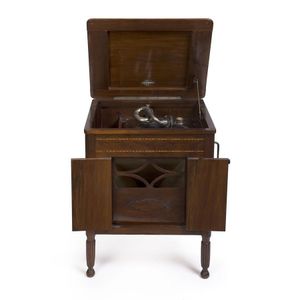Louis XVI Writing Bureau with Ormolu Mounts
You must be a subscriber, and be logged in to view price and dealer details.
Subscribe Now to view actual auction price for this item
When you subscribe, you have the option of setting the currency in which to display prices to $Au, $US, $NZ or Stg.
- Parquetry - Parquetry is inlay laid in geometric patterns, the contrast being achieved by the opposing angles of the grain and veneers. The herringbone pattern is the most commonly used in flooring, but this is almost never seen in furniture - the patterns used are more complex and unlike flooring, can include several different varieties of timber.
- Inlay - Decorative patterns inserted into the main body of a piece of furniture, generally in wood of contrasting colour and grain, though brass, ivory, ebony, shell and sometimes horn have been used. Inlay may consist of a panel of well figured timber inset into a cabinet door front, geometric patterns, or complex and stylized designs of flowers, swags of foliage, fruits and other motifs. As a general rule, in pieces where the carcase is constructed in the solid, the inlay is relatively simple such as stringing, cross banding and herringbone banding. Where more elaborate and decorative work was required veneer was used. Inlay has been fashionable from at least the latter half of the 17th century, when a variety of elaborate forms were developed
- Mounts - Mounts are used to describe bronze, brass and ormolu adornments on furniture especially quality furniture in the rococo and classical revival style, and are also the cabinet makers' name for the metal fittings on furniture, such as hinges, locks and handles, and metal edges and guards which protect furniture from damage.
- Ormolu - Ormolu was popular with French craftsmen in the 18th and 19th century for ornamental fittings for furniture, clocks and other decorative items. True ormolu is gilt bronze, that is bronze that has been coated with gold using a mercury amalgam. Due to the health risks associated with using mercury, this method of creating ormolu was discontinued in France in the 1830s. A substitute was developed consisting of about 75% copper and 25% zinc, however it was inferior to the bronze version. It was often lacquered to prevent it tarnishing.
- Sabre Leg - The sabre leg is commonly associated with chairs made in the Regency or classical revival manner of the early 19th century. The form was copied from designs of the ancient Grecian chair known as a klismos found on painted classical vases. The characteristic of the sabre leg is a wide, sweeping backward curve which was frequently reeded, similar to a sabre. The sweep of the front legs was sometimes complemented by a corresponding curve in the back legs of the chair, though on most domestic furniture the sweep of the rear support was not as pronounced. Sabre legs are often encountered in reproductions of the regency style. They are uncommon in Australian furniture where, by and large, colonial craftsmen preferred to use turned legs.
- Satinwood - Satinwood is a dense pale gold coloured timber that was imported into Britain in the second half of the 18th century, and early 19th centuries from the East Indies and the West Indies. The name derives from the satin-like surface sheen when the timber is polished.
It was used in the solid, as a veneer and in inlays. As well as furniture, satinwood was used for making musical instruments, barometers, boxes and clocks.
It will usually be found on only the very best quality objects, presumably because of of its cost at the time.
This item has been included into following indexes:
Visually similar items

A French Louis XV style 20th century kingwood secretaire - abattant, the rectangular marble top, above an inverted cornice, below a fall front, enclosing leather writing surface pigeon holes and small drawers below three drawers, on tapering supports with

A George III satinwood and sabicu Bonheur-du-jour, attributed to George Simson, circa 1790, with finely figured West Indian satinwood and Caribbean Sabicu veneers and ebony stringing throughout, the superstructure with gallery top above an open bookshelf f

Gilbert gramophone in string inlaid walnut case, circa 1920s. 79 cm high, 61 cm wide, 52 cm deep

An English Regency mahogany pot cupboard, circa 1815 having a tray top, single door with ebony line inlay and ormolu handle, supported on four slender turned legs, 80 cm high, 36 cm wide, 35 cm deep
